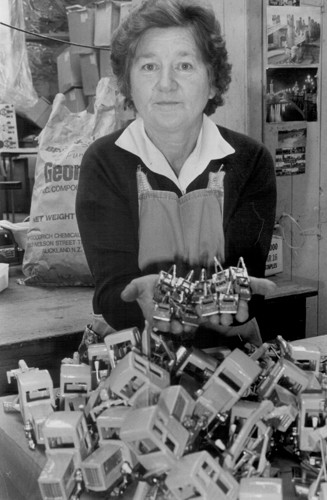
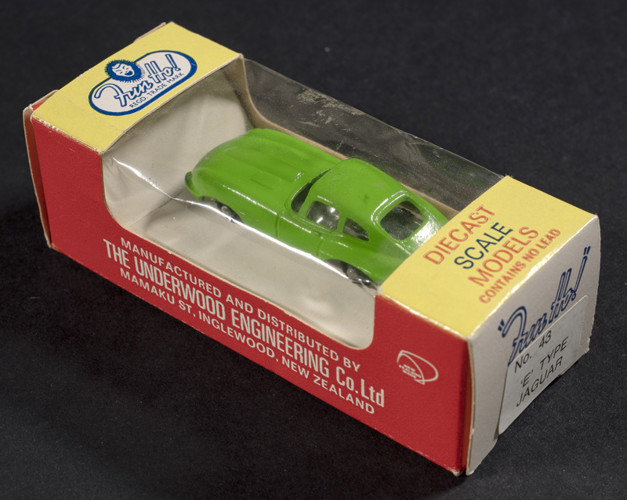
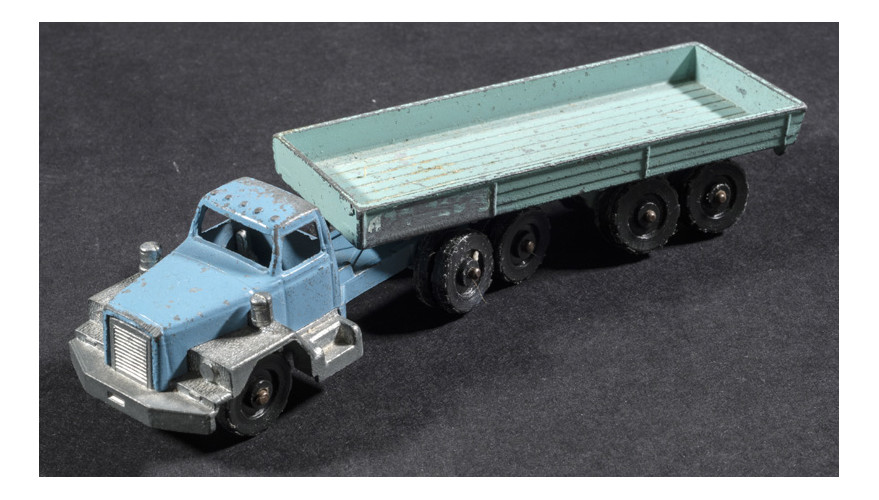
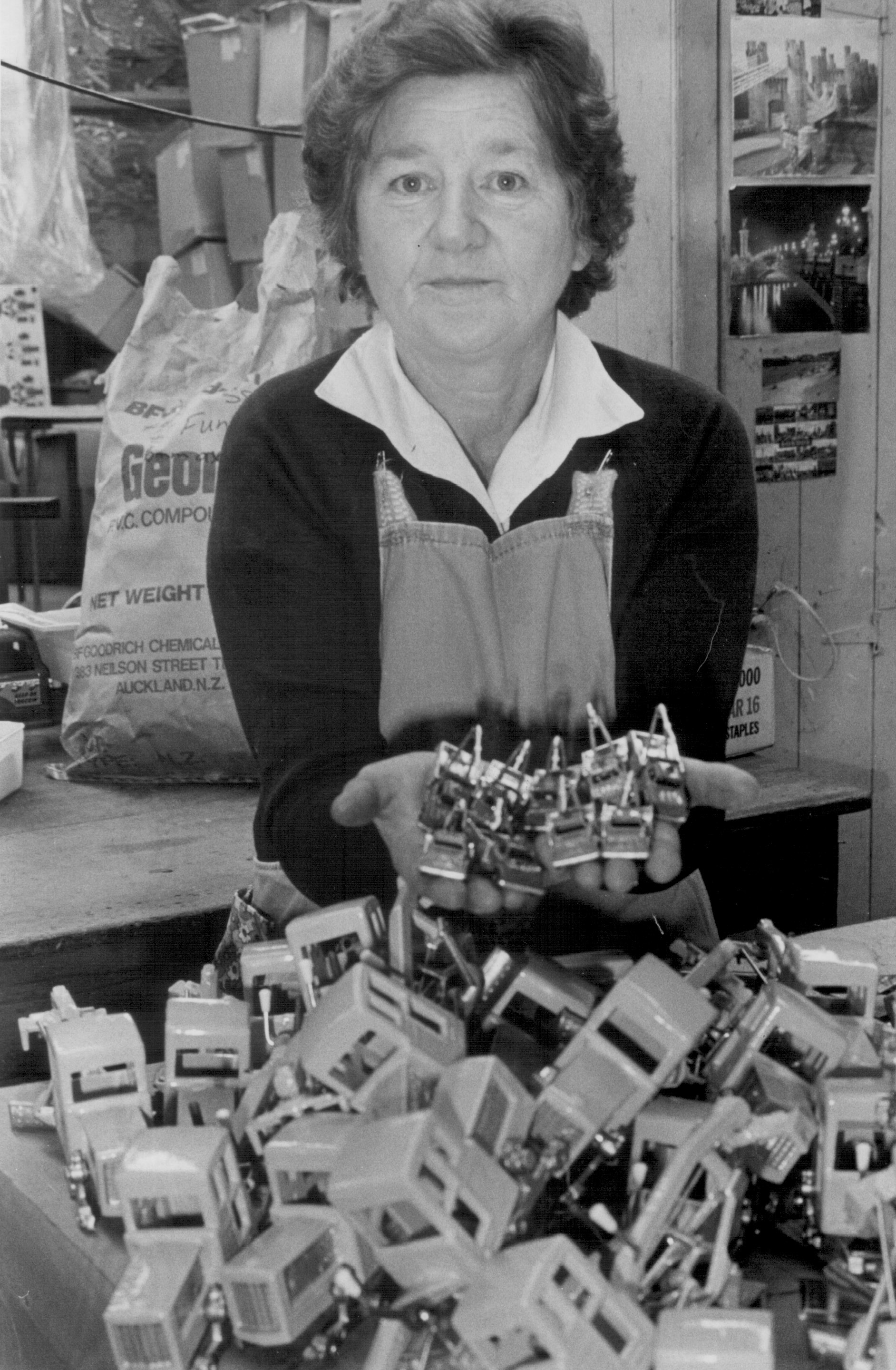
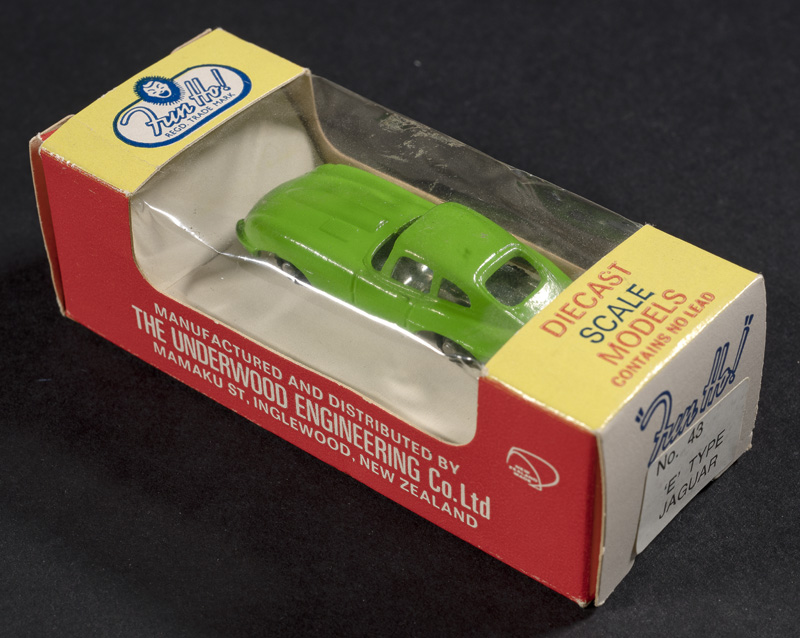
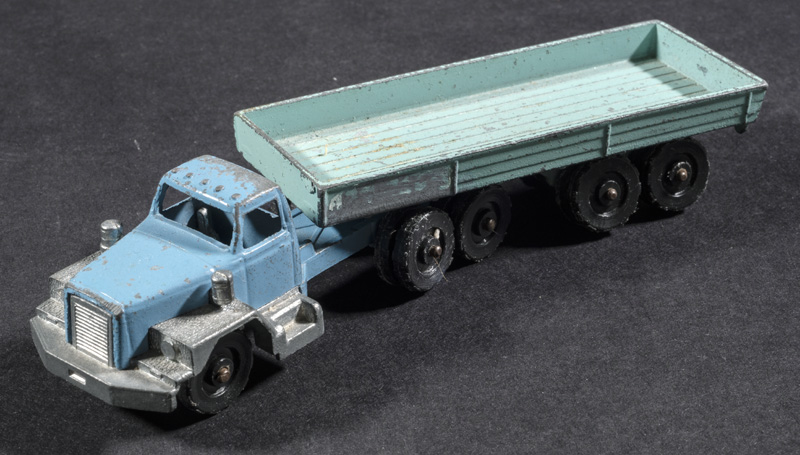
The children on the footpath watch in horror as their school bus powers backwards and smashes into a truck. There is a bang and a crunch of metal. Then silence. A small boy wails. His mother runs to his side and holds him, comforts him in this terrible moment. The bus moves on, revealing the damage. Mother and son bend down to examine the giant toy tip truck and discover a miracle – it's only mildly bent. But the mum, knowing all Fun Ho! Toys will be repaired or replaced free of charge, seizes the moment.
Inglewood's Barry Young laughs at the memory of receiving that truck and accompanying letter about how the school bus ran over it. "You know there was not an axle bent, not a wheel broken, but the tray was twisted slightly so that it didn't sit down square on the cab, but it still went up and down." The company sent out a brand new truck and Barry kept the damaged version as testimony to the strength of those cast metal toys. "Shortly after another chappy rang in to say he had run over his child's giant truck in his car," Barry says. "He had to buy a new tyre for his car. He wasn't very happy, but the truck was alright."
Barry says the Fun Ho! Toys were repaired free of charge up until 1977. However, the founder of the Fun Ho! National Museum at Inglewood reckons the metal playthings will last forever. "One tip truck reached the museum after spending more than 30 years in a farm rubbish tip. Another, a tractor, was dug up after a house burned to the ground, and when new footings were dug, the 1942 tractor was found."
Barry and his wife Phyllis have done their best to make certain the toys do live on. In 1990, they opened the museum in the basement of the Underwood Engineering factory, where the toys used to be made.
The origins of Fun Ho! can be traced to another basement back in about 1935. That was when factory founder Jack Underwood began tinkering with toys beneath the garage of his Wellington home. These early-model toys were made from lead. In about 1940, when the metal was found to be unhealthy, he switched to aluminium.
That same year, Fun Ho! Toys trademark was registered by the Underwood family. This meant that even if the company went into receivership, the trademark would still belong to the family. Barry Young got written permission from the Underwoods to use the Fun Ho! name and classic clown logo for the museum.
Sometime during the World War Two years, the capital-based business ignited – literally. There was a fire in the Underwood factory in Wellington and this sparked a move to Taranaki in 1945. Barry says the firm was based in New Plymouth. "They worked in the old Arcadia Hotel." That building was pulled down in 2001 after failed attempts to save the historic building from demolition.
In 1947, Underwood Engineering shifted its operations to Inglewood, making its home in Mamaku Street. The local folk embraced the multi-company business, which covered many facets of the manufacturing industry. Barry says the family business comprised about six different registered firms. Among the products made were garden furniture, safety car seats for babies, prams and the famous Fun Ho! Toys.
Meanwhile, on the other side of the world a young Englishman was at college learning about dairy farming, especially winter feeding and breeding cattle for shows. One day, this adventurous, London-born fellow decided to take his skills Down Under. So, in 1954, Barry Young headed for New Zealand and fell in love with the lifestyle – and later a woman.
Barry discovered his dairying skills were of no use in his adopted home, so he became a herd-tester. He also tried his hand at a whole range of labouring work, before setting up business as a relief milker. To offset the quiet times, he took a part-time job at Underwood Engineering. "I was bending steel for garden chairs and prams" he remembers. "I thoroughly enjoyed it. I worked by the hour and could leave when I wanted."
But there was a bigger attraction at Underwoods. "Just before morning and afternoon tea time, I noticed this beautiful girl come down [to the factory] and I fell hook, line and sinker. She was good enough to marry me later."
After tying the knot, Barry got offered a job as the sewing room foreman at Underwoods. "Look, I didn't know one end of a sewing machine from the other. But I thought it would be better than getting up at 3am to do relief milking."
Barry quickly moved through the company ranks, becoming purchasing officer in 1970. It was then he became interested in past price lists of the Fun Ho! Toys. He began collecting lists, brochures and catalogues, which he filed away on the top of a cabinet in his large office. He remembers the late Jack Underwood often used these outdated price lists as scrap paper to write messages on. They would be sent around the factory and, somehow, end up in Barry's hands.
Slowly, the young purchasing officer became fascinated by the Fun Ho! creations. "I took an interest in these toys that went back to the late 1930s."
He also became riveted by the toy-making process. "They used to get a toy from overseas and give it to the foundry foreman who would make one in aluminium. That was modified and approved and became a recognised toy" Barry says.
Foreman Ernie Scott would then make four or five plate models. "And when he finished with them, he would throw them up in a hole in the ceiling of the loft above the foundry. It had one little door up a steep staircase and the door was tightly locked and only Ernie had a key." The reason for the top security was because the plate models were a tiny bit bigger than the toys made on the production line and would have caused major problems if they had got mixed up with the rest.
Barry's toy pursuit led him higher. "I got the key from Ernie and I sat up in the loft in the dust every lunchtime sorting these castings out. There was a pile up there, about the size of a car trailer load." He sorted the toys into categories, uncovering a heap of items he had only read about in the catalogues.
As well as the old toys, Barry bought toys for his three children, so had a fine collection at home. In his office at work, he always had boxes of playthings to show travellers and salesmen what he needed to order. The collection was steadily and spontaneously growing.
Then one day Barry got a call from a man organising a craft show. He had received a last-minute cancellation and had six tables to fill, so asked Barry if Fun Ho! would put on a display of toys. "I thought I would help him out. I picked up every Fun Ho! Toy I could get my hands on and took them down to the hall. I covered the whole of the width of the stage in front of the curtains and also filled the [orchestra] pits. It was fantastic." Family and friends put the display together in just two days. "We worked like galley slaves to get them all sorted out."
The exhibit impressed everyone, even Barry's boss, John Underwood. "He said 'Barry, did we make all those?' He had never seen them – his father [Jack] had made them."
The next Monday, Barry was called in to Jack Underwood's office to tell him about the craft show display. "I told him how I collected all the catalogues, but there were some missing. He said 'You won't find them' and told me about the fire in Wellington." Mr Underwood Senior was so impressed by Barry's zeal that he asked him to put together a collection of the toys for the firm, with the aim of putting on a big show one day. "From then on it was all go, and whatever spare time I had, I would fish up these spare castings."
Like a detective, he pieced together the collection, matching lists to toys and working out what metal plates were missing from the array hanging on the factory wall. But the show didn't go on. In 1987, the company hit hard times and the workers were given four months' notice that their jobs would be gone. In October that year, Barry was called to the boardroom to see the bosses and asked about the stockpile of toys.
"By that time I had amassed a fairly comprehensive collection of Fun Ho! Toys and fancy hardware, that's odds and ends, all in cartons below the boardroom." Then came the sentence that changed Barry's life: "We have decided this – you are the only one who's ever shown interest in the history of the firm [Fun Ho! Toys] – we want you to have all those toys."
Dumbfounded, Barry listened to his next orders. "But we want those toys out of this building by 5pm." This was in case the receivers stepped in, Barry explains. Then in a conspiratorial whisper, he says: "I asked Ernie for the key and I asked the boss, 'Can I have those old castings?' and he said 'Yes'." So Barry cleaned out the factory of everything to do with Fun Ho! Toys. "I came home with a truckload."
Wife Phyllis explains where they were stored. "Everywhere! Our children had left home by then, so we had four bedrooms to fill up." Barry continues: "We had a big garden shed and I couldn't get into it for about three years because of cardboard boxes full of toys, of course." Knowing the toys shouldn't be kept in the dark, the Youngs decided to open a museum.
But first, they needed to get the toys in tip-top condition. Helped by friends, Barry and Phyllis painted each truck, tractor, aeroplane, and racing car, then hung them out to dry on an old-fashioned rotary washing line. Using S-hooks, they strung the playthings in vertical rows until the clothesline looked like a weeping cherry festooned with bold toys instead of blossoms.
Then Barry made cabinets for the toys, fitting them with glass from the old Atkinson Building in New Plymouth. The shelves were made from old school louvre windows, which were cut to fit. These cabinets were fitted into rented rooms below the old Underwood factory, then the toys were carefully placed on the shelves. Once the glass fronts were screwed in place, the Fun Ho! National Toy Museum was ready to open.
The Youngs decided to fling the doors open with a fanfare. So, they invited other hobby and craft groups to join the celebration. The entire factory was set up with displays of Smurfs, dolls, model railways, teaspoons, models of corgi dogs, along with police, taxi, post office and Coca Cola memorabilia.
"The Legion of Frontiersman slept in the factory all night to look after the place" Barry says. On 24 March 1990 the fun began. The Eltham Pipe Band blew in, vintage cars were parked for perusal, a swap meet was set up, the Inglewood Lionesses fed the masses, extra Fun Ho! Toys were on sale and visitors flooded the factory. "John Underwood stood on the roof of the toy factory and took photos."
The two-day celebration attracted more than 2000 people and Barry was heartened by the support of local folk. After the big bang opening, visitors kept coming. Officially, the museum was open from 12 noon to 4pm every Saturday afternoon.
Unofficially, Barry and Phyllis were on call. "We would open on demand" he says, explaining how impromptu visitors were a regular occurrence. "They would come round at all times – usually while we were having a meal. We would've got called out four or five times a week." Other people, including school groups, were able to book for tours.
As the years passed, the museum attracted more and more visitors, but the Young’s were getting more and more tired. "We got to the stage we wanted out, being tied down every weekend." There had been many offers to buy the museum, but all these had come from beyond Taranaki and even out of New Zealand.
Barry turned down all potential buyers, because he was adamant the Fun Ho! National Toy Museum toys would stay in Inglewood. He approached service clubs about buying the museum for the town, and the New Plymouth District Council provided money for a feasibility study.
In 1999, community groups came to the rescue, including the Taranaki Electricity Trust (TET). The former Crossroad Promotions group bought the collection from Barry, with funds via the Inglewood Development Trust. The TET provided the money to buy the collection and also the former Inglewood Post Office, where the museum now lives.
Fine print in the legal work secured the Fun Ho! museum's place in the world. One of the conditions was that the museum collection wasn't to be sold to outsiders. "It's got to stay in Inglewood" Barry says. These days, a bright red fire engine is the museum's logo and an enlarged toy version sits on the roof of the building like a beacon of childhood.
However, it's unlikely that youngsters will be the saviours of the national collection. While kids love the brightly painted, simple toys, there's another segment of society who pore over internet sites, haunt garage sales and church fairs. "Of course there are the big kids too" says Barry, a blue metal policeman moneybox sitting in front of him. "It's really the collectors who will be the saviours of Fun Ho!"
Please do not reproduce these images without permission from Puke Ariki.
Contact us for more information or you can order images online here.